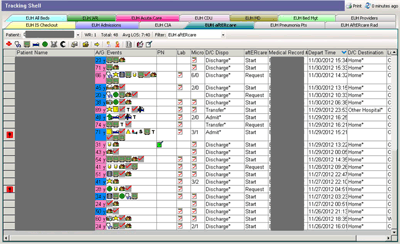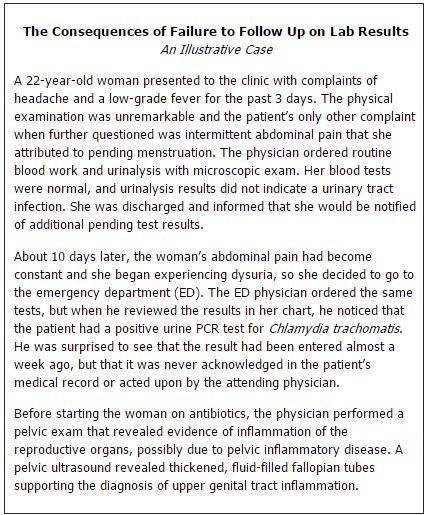Failure to Follow Up on Test Results
 Failing to follow up on test results is a major problem in healthcare that contributes to unsafe patient care, particularly in ambulatory settings. In fact, almost a quarter of all medical errors occurring in outpatient settings can be attributed to poor follow-up of abnormal test results and are believed to represent 25% of malpractice lawsuits involving failures or delays in diagnosis.
Failing to follow up on test results is a major problem in healthcare that contributes to unsafe patient care, particularly in ambulatory settings. In fact, almost a quarter of all medical errors occurring in outpatient settings can be attributed to poor follow-up of abnormal test results and are believed to represent 25% of malpractice lawsuits involving failures or delays in diagnosis.
In the October 2012 issue of CLN's Patient Safety Focus, I asked readers to respond to the following question: How does your lab ensure that pending lab results get to providers after a patient is discharged? Jaime Noguez, PhD, a clinical chemistry fellow at Emory University, Atlanta, provides her healthcare system's information technology (IT) approach to this communication problem, as well as that used by Brigham and Women's Hospital in Boston.
Corinne Fantz, PhD
Patient Safety Editorial Board Member
No News Is Not Always Good News
How IT Solutions Can Help Avert the Failures
By Jaime Noguez, PhD
Clinical laboratorians have primarily focused their efforts on reducing errors in the analytical phase of testing. Today, this phase of the total testing process is one of the most reliable systems in healthcare. However, the measure of success in laboratory medicine is based on all phases of the total testing process, from test ordering to appropriately interpreting and reacting to results. Because the clinical laboratory has historically been at the forefront of quality improvement activities in healthcare, we are well positioned to take on the next challenge for laboratory medicine: helping clinicians and other healthcare providers tackle the errors in the "extra-analytic" phases of the total testing cycle (Figure 1) (1).
Figure 1
Conceptual Framework of the Testing Process

Test Result Management Systems
In 2008, Emory University Hospitals implemented a unique system to improve the emergency department's (ED) management of test results. Known as aftER Care, the system consists of an automated information service that enables clinicians and other qualified healthcare providers to manage results by automatically generating aftER Care events for every discharged patient with pending test results. These pending test results are usually for tests with long turnaround times, such as blood cultures or sexually transmitted diseases. The system populates these events into a list that must be reviewed by the end of each shift (Figure 2).
Figure 2
Summary Screen of aftER Care This screen allows healthcare providers to view all pending laboratory results and clear the event from the list after results have been acknowledged.
This screen allows healthcare providers to view all pending laboratory results and clear the event from the list after results have been acknowledged.
Once the provider has acknowledged receipt of the test results, the event is signed electronically and cleared from the list. If the discharged patient cannot be reached by phone after several attempts, the system generates a letter using the address on file and it is sent to the patient via certified mail. Because patients in the ED sometimes provide incorrect contact information, the discharge documentation given to patients includes a phone number they can call to follow up on test results or with other questions regarding their treatment plans.
ED chief nurse practitioner, Antionette Ward, NP, DNP, believes the aftER Care program has made pending test result management much easier compared to the previous paper-based system by condensing and organizing these events into a single-file format that can be tracked easily. The system also has been beneficial as a tool to document follow-up and provide feedback to clinicians about their diagnostic successes and failures. Recent data indicate that aftER Care has allowed Emory to close the loop on 99.8% of test results.
A similar system to address efficiency and reliability of test result follow-up has been developed and implemented at Brigham and Women's Hospital in Boston. The Longitudinal Medical Record Results Manager allows clinicians to review all chemistry, microbiology, hematology, radiology, and pathology results and document electronically that the appropriate caregiver has received the results. A major benefit of this system is that it enables clinicians to review the results in the context of the patient's previous findings, in addition to the individual's clinical history and medication list.
A few fail-safe mechanisms have been built into this system, such as nightly e-mail reminders that are sent to providers if critical lab results have been filed, but not acknowledged, and the ability for users to allow colleagues to review test results on their behalf (2). Although more comprehensive studies evaluating the success of Results Manager are underway, a small, randomized trial found that the percentage of documented follow-ups to post-discharge microbiology culture results more than doubled (3).

The Pros and Cons of IT Solutions
Managing follow-up of test results is a complex process. Using IT clearly has the potential to reduce the number of missed results by ensuring a safer and more systematic process; however, implementing technological solutions alone will not solve the problem of inadequate test follow-up. Busy physicians are tasked with assimilating massive amounts of information dumped into the electronic medical record (EMR) by different departments, including the lab, the pharmacy, radiology, and others. This requires physicians to spend a considerable amount of time filtering the information provided by each department in order to create a clinical picture of the patient and to develop a diagnosis and treatment plan. Because this data assimilation process is so intensive and prone to error, patient care is safer when these data can be easily visualized in an organized manner.
Table 1
Overcoming IT Problems in Electronic Results Management Systems |
| IT Problem |
Patient Safety Net |
| Test result delivery. |
Track acknowledgement of test result delivery and report failures to responsible party. |
| Data organized in departmental silos. |
Integrate reports, including pharmacy changes linked to pertinent lab results. |
| Too many general alerts leading to alert fatigue. |
Design alerts to fit in clinician workflow and use them sparingly. |
IT solutions fail, however, when the data are present but critical information is overlooked. A root cause of this type of failure is organizing data into separate silos in the EMR. For example, lab data on microbial resistance and pharmacy data related to medication and dosage filed in two separate places in the EMR may cause a physician to continue an inappropriate antibiotic treatment because he didn't check both. Connecting these two sets of data is likely to result in a decrease in medical errors. Furthermore, overall utilization and quality of laboratory testing, pharmacotherapy, and patient safety improves, as one study documented (4).
IT also fails when tools intended to aid medical providers, such as alerts, actually hamper their efforts. For example, pop-up alerts can be beneficial to notify physicians that the test being ordered is potentially redundant. But poorly executed systems sometimes produce excessive alerts that can overburden busy physicians and result in what is commonly called alert fatigue. When this happens, physicians often ignore important messages (5).
On the other hand, IT solutions can improve result management if they are properly integrated into healthcare providers' workflow. For instance, high-priority alerts with clinically significant information like low glucose levels in a patient on high-dose insulin must be delivered on a timely basis so that providers have sufficient time to take action. Similarly, structured handoffs based on computerized checklists can help transmit clinically significant test results during shift changes (6, 7).

Does laboratory result management tie your physicians down?
Sharing Knowledge of Systems
Clinical laboratorians are well positioned to play a greater role in reducing test result follow-up errors. We are well versed in using information systems to flag and document abnormal test results and critical values. In addition, we have stringent protocols, strategic processes, and efficient workflow designs along with clear definitions of the responsibilities of each individual in the laboratory. Given this combination of skills and systems, we stand in a unique position to help clinicians develop a systematic method for test result follow-up using the same or similar strategies already used to effectively manage patient results within the laboratory.
REFERENCES
- Hickner J, Graham DG, Elder NC, et al. Testing process errors and their harms and consequences reported from family medicine practices: A study of the American Academy of Family Physicians National Research Network. Qual Saf Health Care 2008;17:194–200.
- Poon EG, Wang SJ, Gandhi TK, et al. Design and implementation of a comprehensive outpatient Results Manager. J Biomed Inform 2003;36:80–91.
- Poon EG, El-Kareh R, Roy C, et al. Impact of automated alerts on follow-up of post-discharge microbiology results: A cluster randomized controlled trial. J Gen Intern Med 2012;27:1243–50.
- Schiff GD, Klass D, Peterson J, et al. Linking laboratory and pharmacy: Opportunities for reducing errors and improving care. Arch Intern Med 2003;163:893–900.
- Appold K. Alert fatigue: When too many alerts lose physicians' attention. Clin Lab News 2010;36:19.
- Grimm, E. Shift-to-shift communication: What can labs learn from NASA and other highly reliable organizations. Clin Lab News 2011;37:14.
- Fantz, C. The checklist movement: Why laboratories should embrace memory aids. Clin Lab News 2011;37:18–19.
 Jaime Noguez, PhD, is a clinical chemistry fellow at Emory University, Atlanta, Ga.
Jaime Noguez, PhD, is a clinical chemistry fellow at Emory University, Atlanta, Ga.
Email: [email protected]